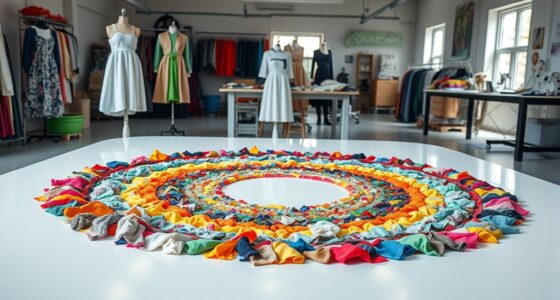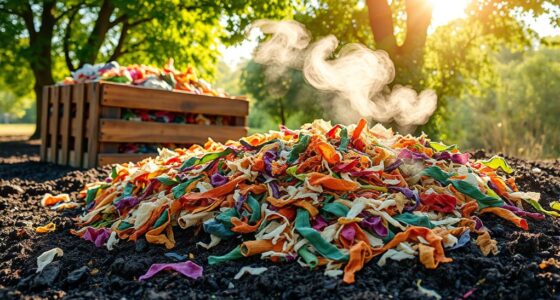You can follow the journey of recycled polyester from PET bottles to runway by understanding its eco-friendly manufacturing process, where bottles are collected, cleaned, shredded, and melted into fibers. This sustainable method reduces reliance on virgin resources and addresses plastic pollution. With growing demand and industry adoption, recycled polyester is now versatile, matching traditional fibers in quality and performance. Keep exploring how innovations in recycling tech are shaping fashion’s eco-conscious future.
Key Takeaways
- Recycled polyester starts with collecting and cleaning PET bottles, then shredding them into small flakes for processing.
- The flakes are melted and spun into fibers, reducing energy and water use compared to virgin polyester.
- These fibers are used in fashion, from casual wear to luxury collections, maintaining high quality and performance.
- Growing demand and industry adoption drive innovations, making recycled polyester mainstream and environmentally friendly.
- The process supports sustainability by transforming waste into fashionable textiles, promoting a circular economy in the fashion industry.

Recycled polyester business is gaining momentum as companies seek sustainable alternatives to traditional textiles. As a consumer or industry professional, you’re likely aware of the growing emphasis on eco-friendly practices, and recycled polyester fits right into this shift. It’s a material produced through sustainable manufacturing processes that transform plastic waste, primarily PET bottles, into high-quality fibers. This approach not only reduces reliance on virgin petroleum-based resources but also addresses the mounting issue of plastic pollution. Market trends clearly indicate that the demand for recycled polyester is surging, driven by both consumer preferences and regulatory pressures. More brands are incorporating recycled fibers into their collections, recognizing the importance of sustainability in their brand identity and supply chain transparency.
Understanding the sustainable manufacturing behind recycled polyester is key. The process begins with collecting PET bottles, which are thoroughly cleaned and sorted to eliminate contaminants. These bottles are then shredded into small flakes, which are melted down and spun into fibers. This process markedly cuts down energy consumption and water use compared to traditional polyester production. As a result, you can see how recycled polyester aligns with the principles of sustainable manufacturing—reducing environmental impact while maintaining product quality. Manufacturers are continuously refining these techniques, making the process more efficient and scalable to meet increasing demand. Furthermore, innovations in recycling technologies are enabling even higher quality fibers to be produced from plastic waste.
Market trends show that recycled polyester isn’t just a niche product anymore; it’s becoming a mainstream material in the fashion and textile industries. You’ll notice more brands promoting their use of recycled fibers, highlighting their commitment to sustainability. Consumers are increasingly making purchasing decisions based on a brand’s environmental footprint, which incentivizes companies to invest in recycled polyester. Additionally, regulations and industry standards are evolving to favor sustainable materials, further boosting market adoption. The versatility of recycled polyester makes it suitable for everything from casual wear to high-end fashion, and its performance characteristics closely match those of virgin polyester, making it a practical choice.
As the industry continues to evolve, you can expect new innovations to emerge, further optimizing the sustainability and quality of recycled polyester. This ongoing development supports a circular economy, where waste becomes a resource rather than a problem. For you, whether as a consumer, designer, or manufacturer, embracing recycled polyester means participating in a more sustainable future—one where fashion and textiles are aligned with environmental responsibility. The market trends suggest this shift is only going to accelerate, making recycled polyester a vital element in the future of eco-conscious manufacturing and design.
Frequently Asked Questions
What Are the Environmental Benefits of Recycled Polyester?
Recycled polyester offers significant sustainable benefits by reducing pollution and conserving resources. When you choose products made from recycled polyester, you’re helping lower landfill waste and decrease reliance on virgin plastics. This process minimizes environmental impact, promotes pollution reduction, and supports eco-friendly practices. By opting for recycled materials, you actively contribute to a greener future and encourage more sustainable production methods in the fashion industry.
How Does Recycled Polyester Compare in Quality to Virgin Polyester?
You might wonder how recycled polyester stacks up against virgin polyester. In many cases, recycled polyester offers comparable fiber durability and color retention, making it a reliable choice. Advances in recycling technology guarantee the quality remains high, so garments last long and keep their vibrant colors. While some initially worry about performance, you’ll find that recycled polyester performs just as well, helping you make eco-friendly choices without sacrificing quality.
What Are the Main Challenges in Recycling PET Bottles Into Textiles?
When recycling PET bottles into textiles, you face main challenges like contamination issues, which can compromise the quality of the recycled material. Additionally, a weak collection infrastructure hampers consistent supply and efficient sorting. These factors make it difficult to produce high-quality recycled polyester reliably. Improving collection systems and addressing contamination are essential steps to streamline the recycling process and enhance the sustainability of the final product.
Which Brands Are Leading the Use of Recycled Polyester?
Imagine stumbling upon brands that are truly leading the way in sustainable fashion. You’ll find Patagonia, Adidas, and Stella McCartney spearheading the use of recycled polyester, turning eco-friendly initiatives into stylish reality. These brands recognize the importance of reducing plastic waste, making them pioneers in eco-conscious design. By choosing their products, you support a greener future, proving that fashion can be both trendy and environmentally responsible.
How Cost-Effective Is Producing Recycled Polyester Versus Virgin Material?
You might wonder how cost-effective recycled polyester production is compared to virgin materials. A thorough cost analysis shows recycled polyester often has lower raw material costs, especially with increasing production efficiency. While initial setup can be higher, ongoing expenses tend to decrease as processes improve. This makes recycled polyester a competitive, environmentally friendly alternative, offering both cost savings and sustainability benefits in the long run.
Conclusion
Your journey with recycled polyester is like watching a single bottle transform into a vibrant thread, weaving sustainability into fashion’s fabric. Every step you take helps turn waste into a symbol of renewal and hope, reminding us that even discarded things hold the potential for beauty and change. As you embrace this path, you become part of a larger story—where the humble PET bottle becomes a shining runway symbol, demonstrating that transformation starts with you.










